Exploring the Complexity of Diabetes
VerifiedAdded on 2019/09/25
|16
|5145
|417
Report
AI Summary
This collection of research articles and studies focuses on various aspects of diabetes, including diagnosis accuracy, nutrition therapy, autoimmune antibodies, hyperglycemia management, uric acid levels, cardiovascular outcomes, and DNA methylation variations. The studies explore the relationship between diabetes type 1 and 2, disease severity, and patient populations from different regions. Additionally, there is an emphasis on cardiovascular effects of intensive lifestyle intervention in patients with type 2 diabetes.
Contribute Materials
Your contribution can guide someone’s learning journey. Share your
documents today.
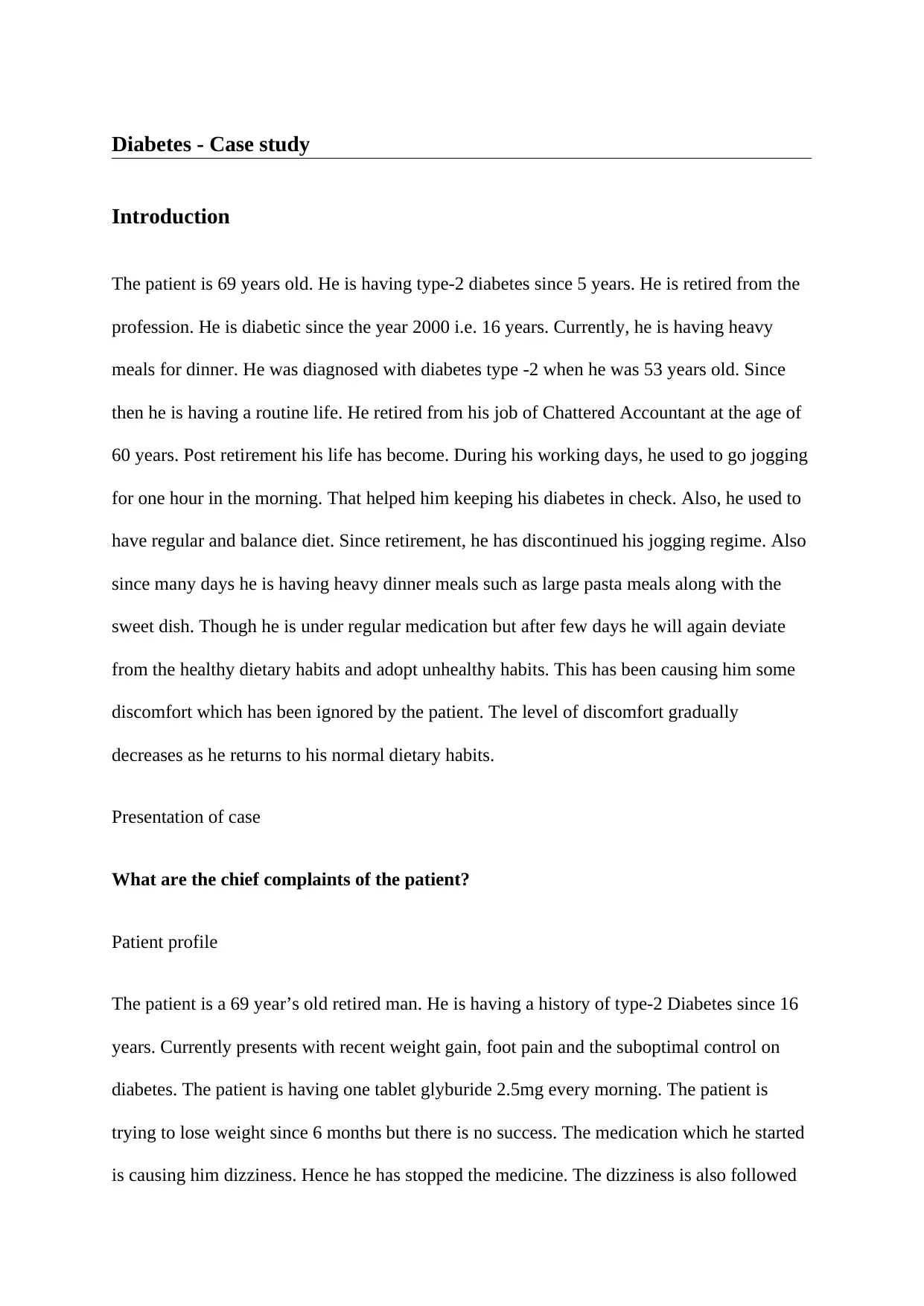
Diabetes - Case study
Introduction
The patient is 69 years old. He is having type-2 diabetes since 5 years. He is retired from the
profession. He is diabetic since the year 2000 i.e. 16 years. Currently, he is having heavy
meals for dinner. He was diagnosed with diabetes type -2 when he was 53 years old. Since
then he is having a routine life. He retired from his job of Chattered Accountant at the age of
60 years. Post retirement his life has become. During his working days, he used to go jogging
for one hour in the morning. That helped him keeping his diabetes in check. Also, he used to
have regular and balance diet. Since retirement, he has discontinued his jogging regime. Also
since many days he is having heavy dinner meals such as large pasta meals along with the
sweet dish. Though he is under regular medication but after few days he will again deviate
from the healthy dietary habits and adopt unhealthy habits. This has been causing him some
discomfort which has been ignored by the patient. The level of discomfort gradually
decreases as he returns to his normal dietary habits.
Presentation of case
What are the chief complaints of the patient?
Patient profile
The patient is a 69 year’s old retired man. He is having a history of type-2 Diabetes since 16
years. Currently presents with recent weight gain, foot pain and the suboptimal control on
diabetes. The patient is having one tablet glyburide 2.5mg every morning. The patient is
trying to lose weight since 6 months but there is no success. The medication which he started
is causing him dizziness. Hence he has stopped the medicine. The dizziness is also followed
Introduction
The patient is 69 years old. He is having type-2 diabetes since 5 years. He is retired from the
profession. He is diabetic since the year 2000 i.e. 16 years. Currently, he is having heavy
meals for dinner. He was diagnosed with diabetes type -2 when he was 53 years old. Since
then he is having a routine life. He retired from his job of Chattered Accountant at the age of
60 years. Post retirement his life has become. During his working days, he used to go jogging
for one hour in the morning. That helped him keeping his diabetes in check. Also, he used to
have regular and balance diet. Since retirement, he has discontinued his jogging regime. Also
since many days he is having heavy dinner meals such as large pasta meals along with the
sweet dish. Though he is under regular medication but after few days he will again deviate
from the healthy dietary habits and adopt unhealthy habits. This has been causing him some
discomfort which has been ignored by the patient. The level of discomfort gradually
decreases as he returns to his normal dietary habits.
Presentation of case
What are the chief complaints of the patient?
Patient profile
The patient is a 69 year’s old retired man. He is having a history of type-2 Diabetes since 16
years. Currently presents with recent weight gain, foot pain and the suboptimal control on
diabetes. The patient is having one tablet glyburide 2.5mg every morning. The patient is
trying to lose weight since 6 months but there is no success. The medication which he started
is causing him dizziness. Hence he has stopped the medicine. The dizziness is also followed
Secure Best Marks with AI Grader
Need help grading? Try our AI Grader for instant feedback on your assignments.
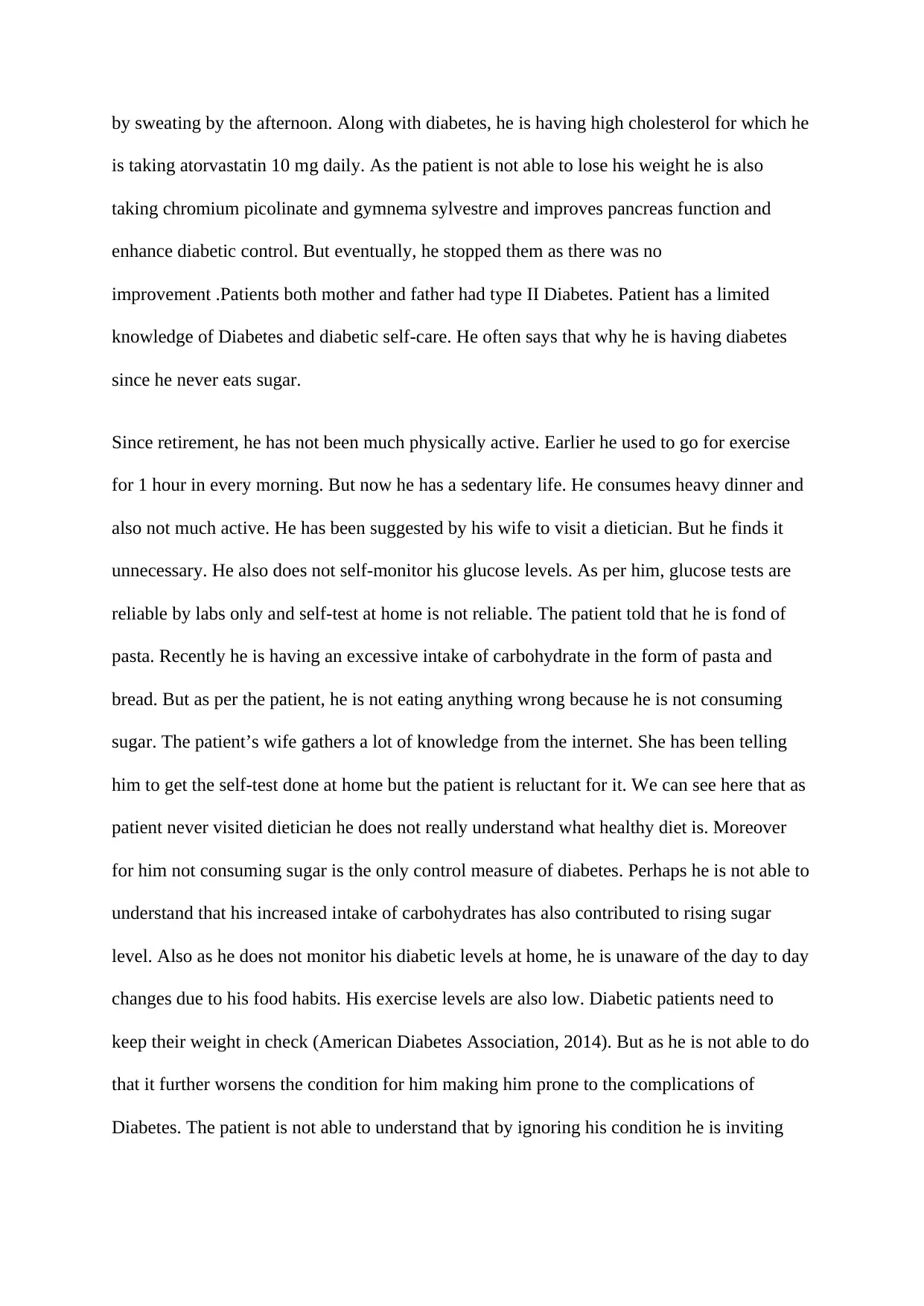
by sweating by the afternoon. Along with diabetes, he is having high cholesterol for which he
is taking atorvastatin 10 mg daily. As the patient is not able to lose his weight he is also
taking chromium picolinate and gymnema sylvestre and improves pancreas function and
enhance diabetic control. But eventually, he stopped them as there was no
improvement .Patients both mother and father had type II Diabetes. Patient has a limited
knowledge of Diabetes and diabetic self-care. He often says that why he is having diabetes
since he never eats sugar.
Since retirement, he has not been much physically active. Earlier he used to go for exercise
for 1 hour in every morning. But now he has a sedentary life. He consumes heavy dinner and
also not much active. He has been suggested by his wife to visit a dietician. But he finds it
unnecessary. He also does not self-monitor his glucose levels. As per him, glucose tests are
reliable by labs only and self-test at home is not reliable. The patient told that he is fond of
pasta. Recently he is having an excessive intake of carbohydrate in the form of pasta and
bread. But as per the patient, he is not eating anything wrong because he is not consuming
sugar. The patient’s wife gathers a lot of knowledge from the internet. She has been telling
him to get the self-test done at home but the patient is reluctant for it. We can see here that as
patient never visited dietician he does not really understand what healthy diet is. Moreover
for him not consuming sugar is the only control measure of diabetes. Perhaps he is not able to
understand that his increased intake of carbohydrates has also contributed to rising sugar
level. Also as he does not monitor his diabetic levels at home, he is unaware of the day to day
changes due to his food habits. His exercise levels are also low. Diabetic patients need to
keep their weight in check (American Diabetes Association, 2014). But as he is not able to do
that it further worsens the condition for him making him prone to the complications of
Diabetes. The patient is not able to understand that by ignoring his condition he is inviting
is taking atorvastatin 10 mg daily. As the patient is not able to lose his weight he is also
taking chromium picolinate and gymnema sylvestre and improves pancreas function and
enhance diabetic control. But eventually, he stopped them as there was no
improvement .Patients both mother and father had type II Diabetes. Patient has a limited
knowledge of Diabetes and diabetic self-care. He often says that why he is having diabetes
since he never eats sugar.
Since retirement, he has not been much physically active. Earlier he used to go for exercise
for 1 hour in every morning. But now he has a sedentary life. He consumes heavy dinner and
also not much active. He has been suggested by his wife to visit a dietician. But he finds it
unnecessary. He also does not self-monitor his glucose levels. As per him, glucose tests are
reliable by labs only and self-test at home is not reliable. The patient told that he is fond of
pasta. Recently he is having an excessive intake of carbohydrate in the form of pasta and
bread. But as per the patient, he is not eating anything wrong because he is not consuming
sugar. The patient’s wife gathers a lot of knowledge from the internet. She has been telling
him to get the self-test done at home but the patient is reluctant for it. We can see here that as
patient never visited dietician he does not really understand what healthy diet is. Moreover
for him not consuming sugar is the only control measure of diabetes. Perhaps he is not able to
understand that his increased intake of carbohydrates has also contributed to rising sugar
level. Also as he does not monitor his diabetic levels at home, he is unaware of the day to day
changes due to his food habits. His exercise levels are also low. Diabetic patients need to
keep their weight in check (American Diabetes Association, 2014). But as he is not able to do
that it further worsens the condition for him making him prone to the complications of
Diabetes. The patient is not able to understand that by ignoring his condition he is inviting
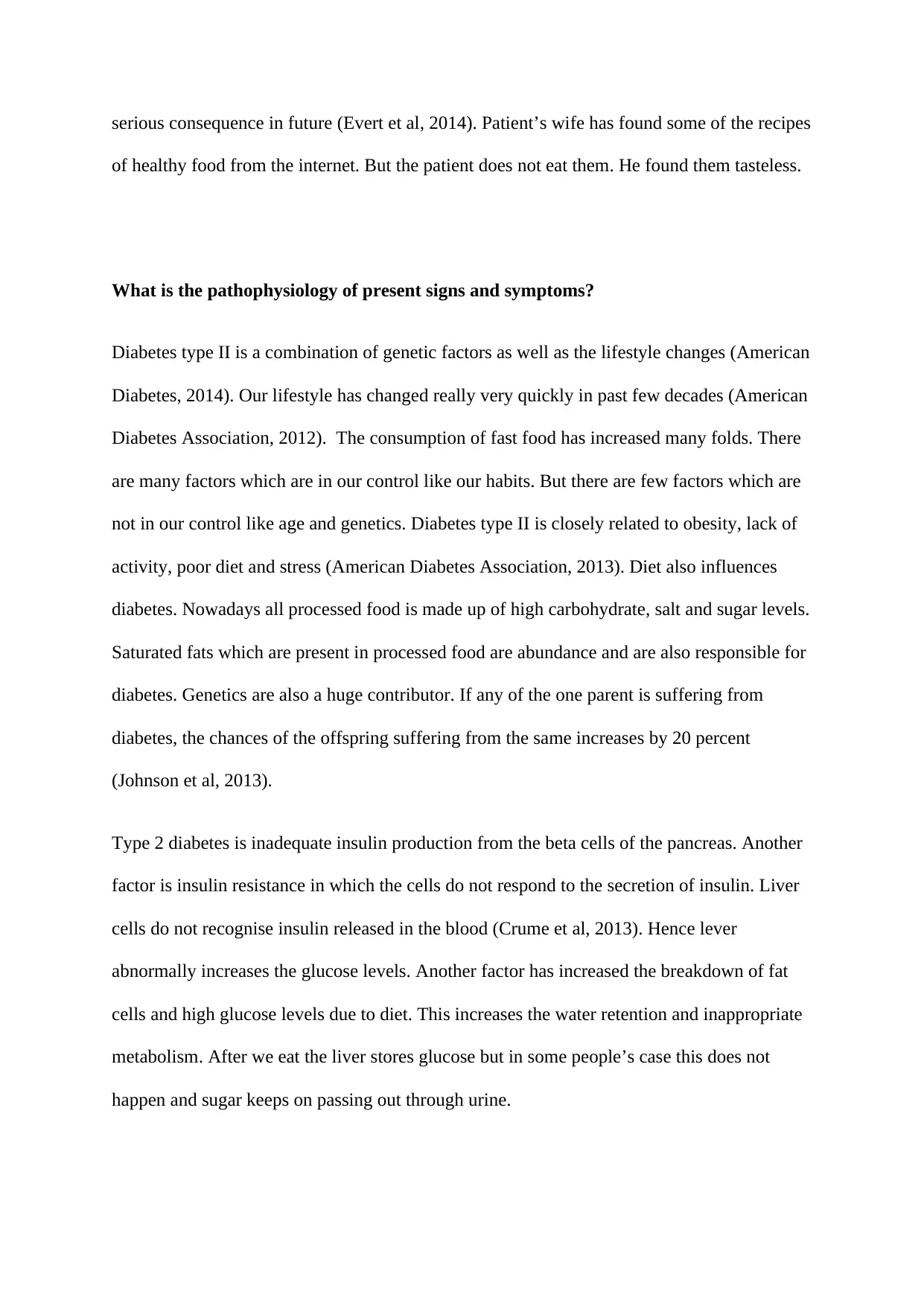
serious consequence in future (Evert et al, 2014). Patient’s wife has found some of the recipes
of healthy food from the internet. But the patient does not eat them. He found them tasteless.
What is the pathophysiology of present signs and symptoms?
Diabetes type II is a combination of genetic factors as well as the lifestyle changes (American
Diabetes, 2014). Our lifestyle has changed really very quickly in past few decades (American
Diabetes Association, 2012). The consumption of fast food has increased many folds. There
are many factors which are in our control like our habits. But there are few factors which are
not in our control like age and genetics. Diabetes type II is closely related to obesity, lack of
activity, poor diet and stress (American Diabetes Association, 2013). Diet also influences
diabetes. Nowadays all processed food is made up of high carbohydrate, salt and sugar levels.
Saturated fats which are present in processed food are abundance and are also responsible for
diabetes. Genetics are also a huge contributor. If any of the one parent is suffering from
diabetes, the chances of the offspring suffering from the same increases by 20 percent
(Johnson et al, 2013).
Type 2 diabetes is inadequate insulin production from the beta cells of the pancreas. Another
factor is insulin resistance in which the cells do not respond to the secretion of insulin. Liver
cells do not recognise insulin released in the blood (Crume et al, 2013). Hence lever
abnormally increases the glucose levels. Another factor has increased the breakdown of fat
cells and high glucose levels due to diet. This increases the water retention and inappropriate
metabolism. After we eat the liver stores glucose but in some people’s case this does not
happen and sugar keeps on passing out through urine.
of healthy food from the internet. But the patient does not eat them. He found them tasteless.
What is the pathophysiology of present signs and symptoms?
Diabetes type II is a combination of genetic factors as well as the lifestyle changes (American
Diabetes, 2014). Our lifestyle has changed really very quickly in past few decades (American
Diabetes Association, 2012). The consumption of fast food has increased many folds. There
are many factors which are in our control like our habits. But there are few factors which are
not in our control like age and genetics. Diabetes type II is closely related to obesity, lack of
activity, poor diet and stress (American Diabetes Association, 2013). Diet also influences
diabetes. Nowadays all processed food is made up of high carbohydrate, salt and sugar levels.
Saturated fats which are present in processed food are abundance and are also responsible for
diabetes. Genetics are also a huge contributor. If any of the one parent is suffering from
diabetes, the chances of the offspring suffering from the same increases by 20 percent
(Johnson et al, 2013).
Type 2 diabetes is inadequate insulin production from the beta cells of the pancreas. Another
factor is insulin resistance in which the cells do not respond to the secretion of insulin. Liver
cells do not recognise insulin released in the blood (Crume et al, 2013). Hence lever
abnormally increases the glucose levels. Another factor has increased the breakdown of fat
cells and high glucose levels due to diet. This increases the water retention and inappropriate
metabolism. After we eat the liver stores glucose but in some people’s case this does not
happen and sugar keeps on passing out through urine.
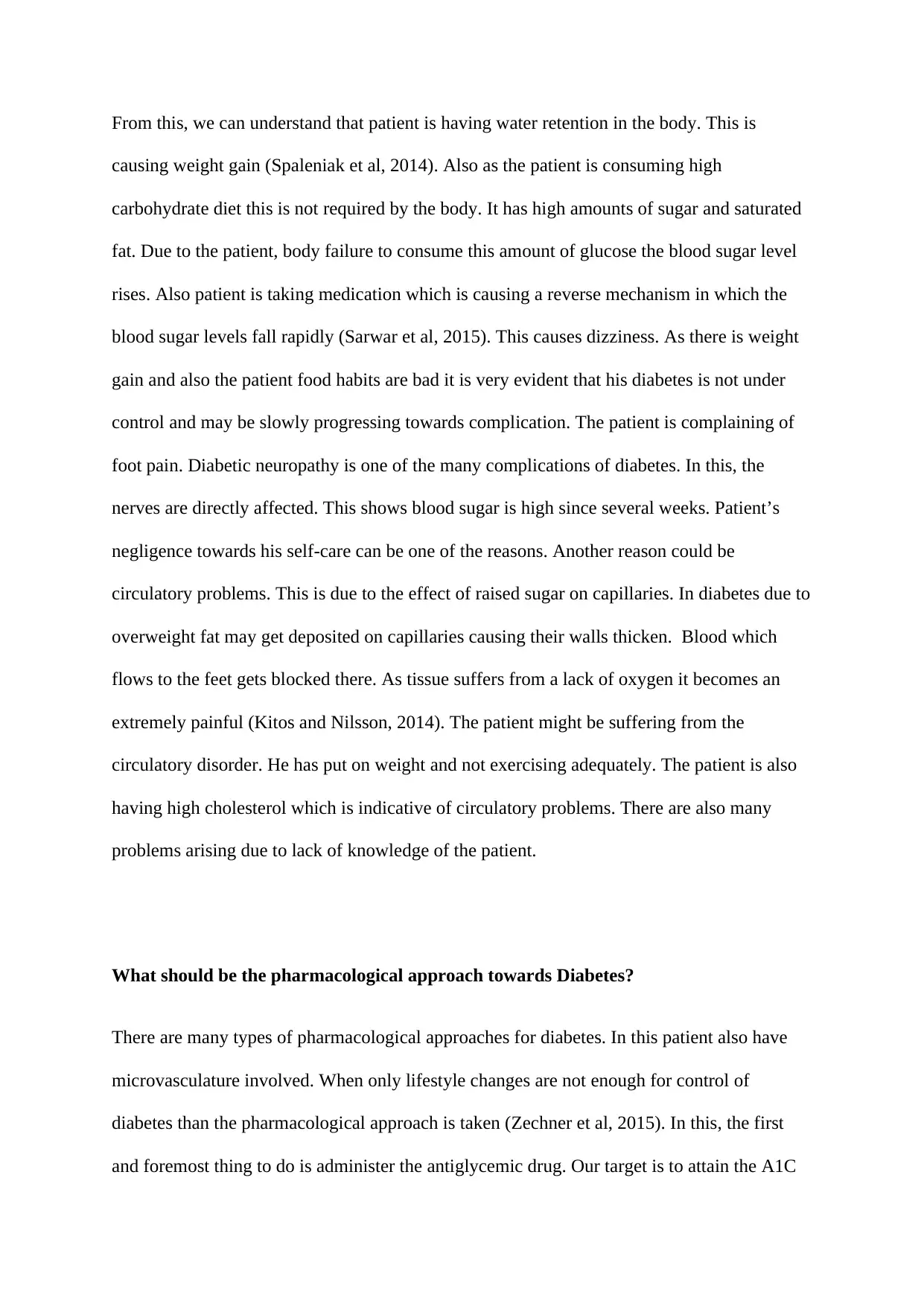
From this, we can understand that patient is having water retention in the body. This is
causing weight gain (Spaleniak et al, 2014). Also as the patient is consuming high
carbohydrate diet this is not required by the body. It has high amounts of sugar and saturated
fat. Due to the patient, body failure to consume this amount of glucose the blood sugar level
rises. Also patient is taking medication which is causing a reverse mechanism in which the
blood sugar levels fall rapidly (Sarwar et al, 2015). This causes dizziness. As there is weight
gain and also the patient food habits are bad it is very evident that his diabetes is not under
control and may be slowly progressing towards complication. The patient is complaining of
foot pain. Diabetic neuropathy is one of the many complications of diabetes. In this, the
nerves are directly affected. This shows blood sugar is high since several weeks. Patient’s
negligence towards his self-care can be one of the reasons. Another reason could be
circulatory problems. This is due to the effect of raised sugar on capillaries. In diabetes due to
overweight fat may get deposited on capillaries causing their walls thicken. Blood which
flows to the feet gets blocked there. As tissue suffers from a lack of oxygen it becomes an
extremely painful (Kitos and Nilsson, 2014). The patient might be suffering from the
circulatory disorder. He has put on weight and not exercising adequately. The patient is also
having high cholesterol which is indicative of circulatory problems. There are also many
problems arising due to lack of knowledge of the patient.
What should be the pharmacological approach towards Diabetes?
There are many types of pharmacological approaches for diabetes. In this patient also have
microvasculature involved. When only lifestyle changes are not enough for control of
diabetes than the pharmacological approach is taken (Zechner et al, 2015). In this, the first
and foremost thing to do is administer the antiglycemic drug. Our target is to attain the A1C
causing weight gain (Spaleniak et al, 2014). Also as the patient is consuming high
carbohydrate diet this is not required by the body. It has high amounts of sugar and saturated
fat. Due to the patient, body failure to consume this amount of glucose the blood sugar level
rises. Also patient is taking medication which is causing a reverse mechanism in which the
blood sugar levels fall rapidly (Sarwar et al, 2015). This causes dizziness. As there is weight
gain and also the patient food habits are bad it is very evident that his diabetes is not under
control and may be slowly progressing towards complication. The patient is complaining of
foot pain. Diabetic neuropathy is one of the many complications of diabetes. In this, the
nerves are directly affected. This shows blood sugar is high since several weeks. Patient’s
negligence towards his self-care can be one of the reasons. Another reason could be
circulatory problems. This is due to the effect of raised sugar on capillaries. In diabetes due to
overweight fat may get deposited on capillaries causing their walls thicken. Blood which
flows to the feet gets blocked there. As tissue suffers from a lack of oxygen it becomes an
extremely painful (Kitos and Nilsson, 2014). The patient might be suffering from the
circulatory disorder. He has put on weight and not exercising adequately. The patient is also
having high cholesterol which is indicative of circulatory problems. There are also many
problems arising due to lack of knowledge of the patient.
What should be the pharmacological approach towards Diabetes?
There are many types of pharmacological approaches for diabetes. In this patient also have
microvasculature involved. When only lifestyle changes are not enough for control of
diabetes than the pharmacological approach is taken (Zechner et al, 2015). In this, the first
and foremost thing to do is administer the antiglycemic drug. Our target is to attain the A1C
Paraphrase This Document
Need a fresh take? Get an instant paraphrase of this document with our AI Paraphraser
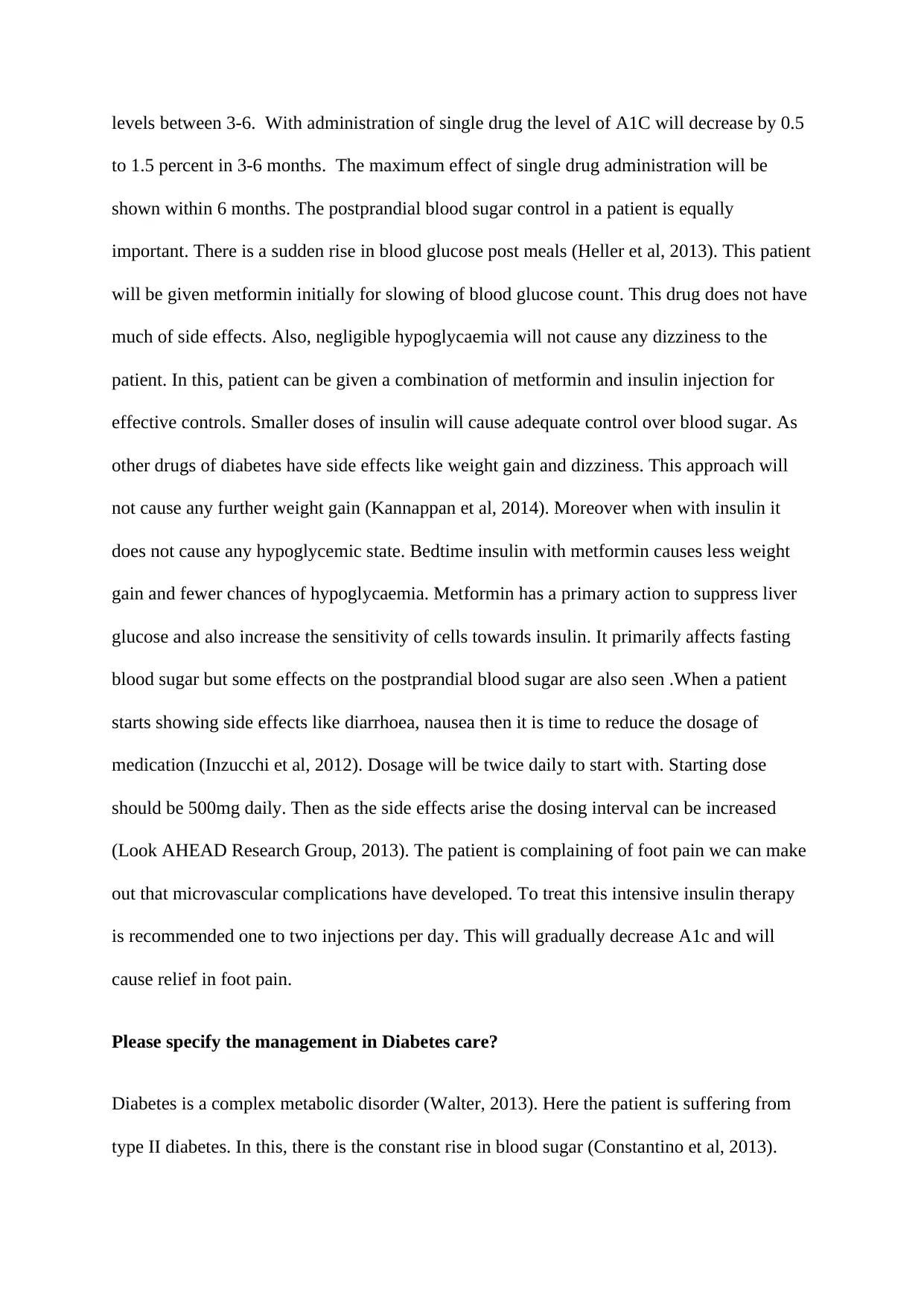
levels between 3-6. With administration of single drug the level of A1C will decrease by 0.5
to 1.5 percent in 3-6 months. The maximum effect of single drug administration will be
shown within 6 months. The postprandial blood sugar control in a patient is equally
important. There is a sudden rise in blood glucose post meals (Heller et al, 2013). This patient
will be given metformin initially for slowing of blood glucose count. This drug does not have
much of side effects. Also, negligible hypoglycaemia will not cause any dizziness to the
patient. In this, patient can be given a combination of metformin and insulin injection for
effective controls. Smaller doses of insulin will cause adequate control over blood sugar. As
other drugs of diabetes have side effects like weight gain and dizziness. This approach will
not cause any further weight gain (Kannappan et al, 2014). Moreover when with insulin it
does not cause any hypoglycemic state. Bedtime insulin with metformin causes less weight
gain and fewer chances of hypoglycaemia. Metformin has a primary action to suppress liver
glucose and also increase the sensitivity of cells towards insulin. It primarily affects fasting
blood sugar but some effects on the postprandial blood sugar are also seen .When a patient
starts showing side effects like diarrhoea, nausea then it is time to reduce the dosage of
medication (Inzucchi et al, 2012). Dosage will be twice daily to start with. Starting dose
should be 500mg daily. Then as the side effects arise the dosing interval can be increased
(Look AHEAD Research Group, 2013). The patient is complaining of foot pain we can make
out that microvascular complications have developed. To treat this intensive insulin therapy
is recommended one to two injections per day. This will gradually decrease A1c and will
cause relief in foot pain.
Please specify the management in Diabetes care?
Diabetes is a complex metabolic disorder (Walter, 2013). Here the patient is suffering from
type II diabetes. In this, there is the constant rise in blood sugar (Constantino et al, 2013).
to 1.5 percent in 3-6 months. The maximum effect of single drug administration will be
shown within 6 months. The postprandial blood sugar control in a patient is equally
important. There is a sudden rise in blood glucose post meals (Heller et al, 2013). This patient
will be given metformin initially for slowing of blood glucose count. This drug does not have
much of side effects. Also, negligible hypoglycaemia will not cause any dizziness to the
patient. In this, patient can be given a combination of metformin and insulin injection for
effective controls. Smaller doses of insulin will cause adequate control over blood sugar. As
other drugs of diabetes have side effects like weight gain and dizziness. This approach will
not cause any further weight gain (Kannappan et al, 2014). Moreover when with insulin it
does not cause any hypoglycemic state. Bedtime insulin with metformin causes less weight
gain and fewer chances of hypoglycaemia. Metformin has a primary action to suppress liver
glucose and also increase the sensitivity of cells towards insulin. It primarily affects fasting
blood sugar but some effects on the postprandial blood sugar are also seen .When a patient
starts showing side effects like diarrhoea, nausea then it is time to reduce the dosage of
medication (Inzucchi et al, 2012). Dosage will be twice daily to start with. Starting dose
should be 500mg daily. Then as the side effects arise the dosing interval can be increased
(Look AHEAD Research Group, 2013). The patient is complaining of foot pain we can make
out that microvascular complications have developed. To treat this intensive insulin therapy
is recommended one to two injections per day. This will gradually decrease A1c and will
cause relief in foot pain.
Please specify the management in Diabetes care?
Diabetes is a complex metabolic disorder (Walter, 2013). Here the patient is suffering from
type II diabetes. In this, there is the constant rise in blood sugar (Constantino et al, 2013).
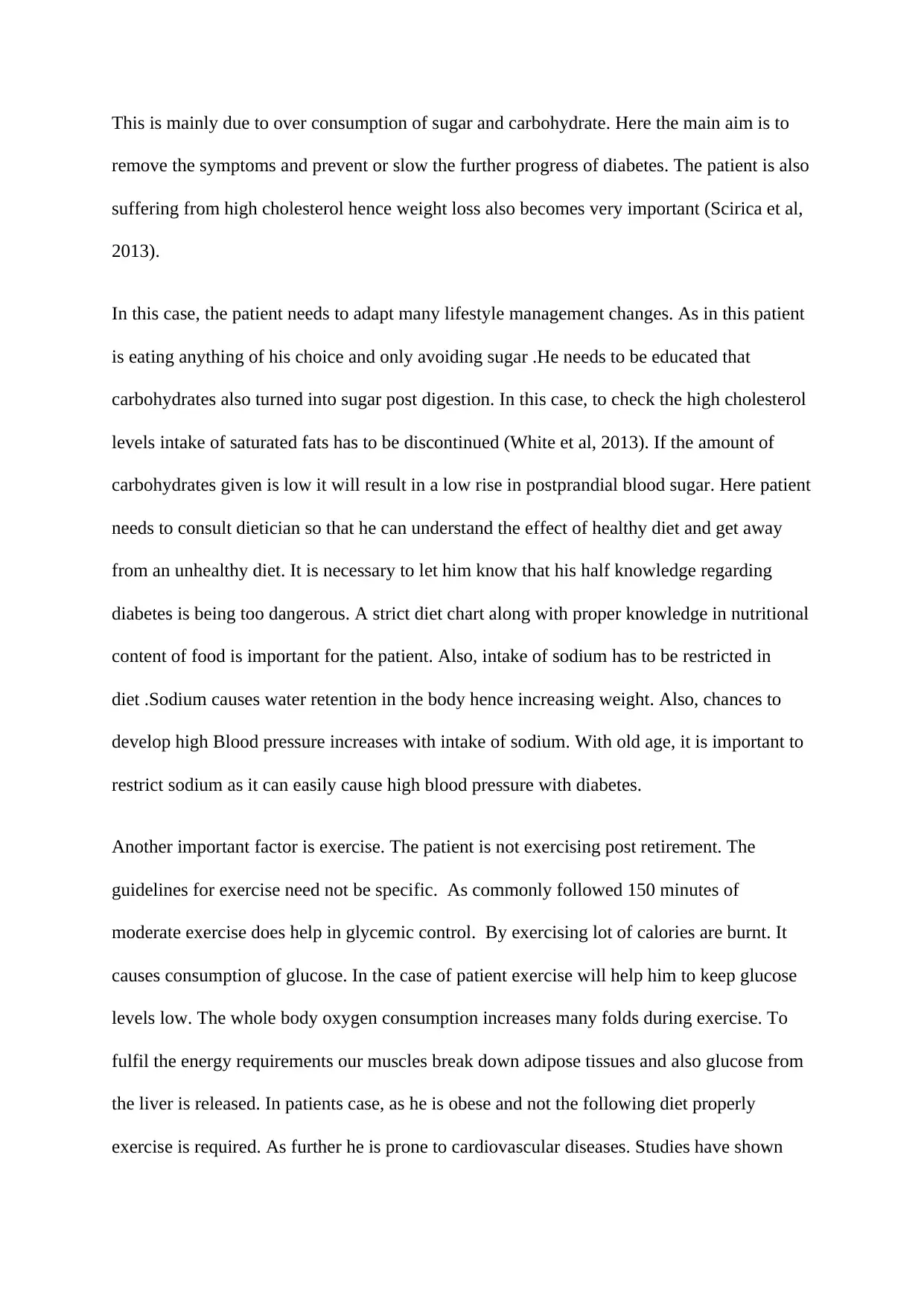
This is mainly due to over consumption of sugar and carbohydrate. Here the main aim is to
remove the symptoms and prevent or slow the further progress of diabetes. The patient is also
suffering from high cholesterol hence weight loss also becomes very important (Scirica et al,
2013).
In this case, the patient needs to adapt many lifestyle management changes. As in this patient
is eating anything of his choice and only avoiding sugar .He needs to be educated that
carbohydrates also turned into sugar post digestion. In this case, to check the high cholesterol
levels intake of saturated fats has to be discontinued (White et al, 2013). If the amount of
carbohydrates given is low it will result in a low rise in postprandial blood sugar. Here patient
needs to consult dietician so that he can understand the effect of healthy diet and get away
from an unhealthy diet. It is necessary to let him know that his half knowledge regarding
diabetes is being too dangerous. A strict diet chart along with proper knowledge in nutritional
content of food is important for the patient. Also, intake of sodium has to be restricted in
diet .Sodium causes water retention in the body hence increasing weight. Also, chances to
develop high Blood pressure increases with intake of sodium. With old age, it is important to
restrict sodium as it can easily cause high blood pressure with diabetes.
Another important factor is exercise. The patient is not exercising post retirement. The
guidelines for exercise need not be specific. As commonly followed 150 minutes of
moderate exercise does help in glycemic control. By exercising lot of calories are burnt. It
causes consumption of glucose. In the case of patient exercise will help him to keep glucose
levels low. The whole body oxygen consumption increases many folds during exercise. To
fulfil the energy requirements our muscles break down adipose tissues and also glucose from
the liver is released. In patients case, as he is obese and not the following diet properly
exercise is required. As further he is prone to cardiovascular diseases. Studies have shown
remove the symptoms and prevent or slow the further progress of diabetes. The patient is also
suffering from high cholesterol hence weight loss also becomes very important (Scirica et al,
2013).
In this case, the patient needs to adapt many lifestyle management changes. As in this patient
is eating anything of his choice and only avoiding sugar .He needs to be educated that
carbohydrates also turned into sugar post digestion. In this case, to check the high cholesterol
levels intake of saturated fats has to be discontinued (White et al, 2013). If the amount of
carbohydrates given is low it will result in a low rise in postprandial blood sugar. Here patient
needs to consult dietician so that he can understand the effect of healthy diet and get away
from an unhealthy diet. It is necessary to let him know that his half knowledge regarding
diabetes is being too dangerous. A strict diet chart along with proper knowledge in nutritional
content of food is important for the patient. Also, intake of sodium has to be restricted in
diet .Sodium causes water retention in the body hence increasing weight. Also, chances to
develop high Blood pressure increases with intake of sodium. With old age, it is important to
restrict sodium as it can easily cause high blood pressure with diabetes.
Another important factor is exercise. The patient is not exercising post retirement. The
guidelines for exercise need not be specific. As commonly followed 150 minutes of
moderate exercise does help in glycemic control. By exercising lot of calories are burnt. It
causes consumption of glucose. In the case of patient exercise will help him to keep glucose
levels low. The whole body oxygen consumption increases many folds during exercise. To
fulfil the energy requirements our muscles break down adipose tissues and also glucose from
the liver is released. In patients case, as he is obese and not the following diet properly
exercise is required. As further he is prone to cardiovascular diseases. Studies have shown

that patients with low fitness levels develop serious cardiovascular complications earlier.
Regular exercises will help to decrease the levels of triglycerides and increase the level of
HDL which is the good cholesterol for the body .Appropriate goal setting during exercise is
important. The patient should aim at losing some weight every month gradually.
In this patient also needs self-management education. In this case, the patient does not rely on
blood sugar testing at home. Patient need to be told that blood sugar has to monitor on a daily
basis. The technique of testing is now very advanced and reliable. Also, a dietary plan
suggesting low intake of carbohydrate is very essential.
With all these above modifications in lifestyle, it is important to provide psychological
support to the patient. Psychological care plays a great role in self-care. It is without any
hindrance to patient medications. At times the psychological support in inadequate. This
affects the quality of self-care. If there will be no one to take care of the patient at that stage
then the patient will not take care of himself. This will cause the onset of the complication of
diabetes at very early stage. As diabetes demand changes at various levels of your life, such
as work related or dietary changes, it is difficult to take these changes permanently into your
life. Patient tends to follow the strict regime for few days but going further they tend to
deviate from the treatment path. As in old age, a comfortable life is preferred over a restricted
life. Caregivers need to pay attention and encourage the patient not to deviate from the path
of health.
What are the conclusions you draw from the above case?
In this case study, the patient is suffering from Type II Diabetes since 16 years. Till the time
patient was not retired he was physically active. Post retirement his physical activities
decreased to a great extent, after that patient does not focus on regular exercises. This has
Regular exercises will help to decrease the levels of triglycerides and increase the level of
HDL which is the good cholesterol for the body .Appropriate goal setting during exercise is
important. The patient should aim at losing some weight every month gradually.
In this patient also needs self-management education. In this case, the patient does not rely on
blood sugar testing at home. Patient need to be told that blood sugar has to monitor on a daily
basis. The technique of testing is now very advanced and reliable. Also, a dietary plan
suggesting low intake of carbohydrate is very essential.
With all these above modifications in lifestyle, it is important to provide psychological
support to the patient. Psychological care plays a great role in self-care. It is without any
hindrance to patient medications. At times the psychological support in inadequate. This
affects the quality of self-care. If there will be no one to take care of the patient at that stage
then the patient will not take care of himself. This will cause the onset of the complication of
diabetes at very early stage. As diabetes demand changes at various levels of your life, such
as work related or dietary changes, it is difficult to take these changes permanently into your
life. Patient tends to follow the strict regime for few days but going further they tend to
deviate from the treatment path. As in old age, a comfortable life is preferred over a restricted
life. Caregivers need to pay attention and encourage the patient not to deviate from the path
of health.
What are the conclusions you draw from the above case?
In this case study, the patient is suffering from Type II Diabetes since 16 years. Till the time
patient was not retired he was physically active. Post retirement his physical activities
decreased to a great extent, after that patient does not focus on regular exercises. This has
Secure Best Marks with AI Grader
Need help grading? Try our AI Grader for instant feedback on your assignments.
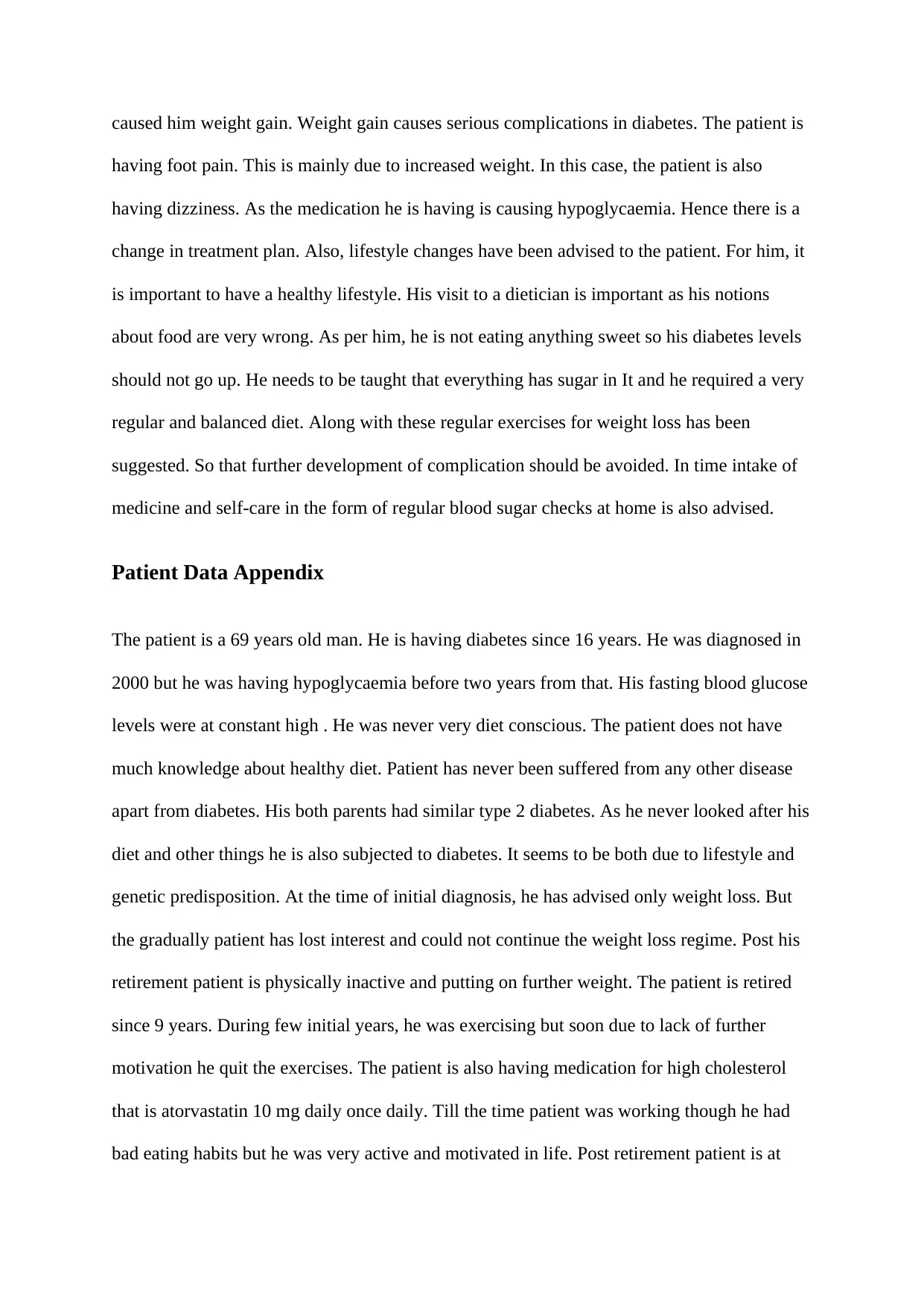
caused him weight gain. Weight gain causes serious complications in diabetes. The patient is
having foot pain. This is mainly due to increased weight. In this case, the patient is also
having dizziness. As the medication he is having is causing hypoglycaemia. Hence there is a
change in treatment plan. Also, lifestyle changes have been advised to the patient. For him, it
is important to have a healthy lifestyle. His visit to a dietician is important as his notions
about food are very wrong. As per him, he is not eating anything sweet so his diabetes levels
should not go up. He needs to be taught that everything has sugar in It and he required a very
regular and balanced diet. Along with these regular exercises for weight loss has been
suggested. So that further development of complication should be avoided. In time intake of
medicine and self-care in the form of regular blood sugar checks at home is also advised.
Patient Data Appendix
The patient is a 69 years old man. He is having diabetes since 16 years. He was diagnosed in
2000 but he was having hypoglycaemia before two years from that. His fasting blood glucose
levels were at constant high . He was never very diet conscious. The patient does not have
much knowledge about healthy diet. Patient has never been suffered from any other disease
apart from diabetes. His both parents had similar type 2 diabetes. As he never looked after his
diet and other things he is also subjected to diabetes. It seems to be both due to lifestyle and
genetic predisposition. At the time of initial diagnosis, he has advised only weight loss. But
the gradually patient has lost interest and could not continue the weight loss regime. Post his
retirement patient is physically inactive and putting on further weight. The patient is retired
since 9 years. During few initial years, he was exercising but soon due to lack of further
motivation he quit the exercises. The patient is also having medication for high cholesterol
that is atorvastatin 10 mg daily once daily. Till the time patient was working though he had
bad eating habits but he was very active and motivated in life. Post retirement patient is at
having foot pain. This is mainly due to increased weight. In this case, the patient is also
having dizziness. As the medication he is having is causing hypoglycaemia. Hence there is a
change in treatment plan. Also, lifestyle changes have been advised to the patient. For him, it
is important to have a healthy lifestyle. His visit to a dietician is important as his notions
about food are very wrong. As per him, he is not eating anything sweet so his diabetes levels
should not go up. He needs to be taught that everything has sugar in It and he required a very
regular and balanced diet. Along with these regular exercises for weight loss has been
suggested. So that further development of complication should be avoided. In time intake of
medicine and self-care in the form of regular blood sugar checks at home is also advised.
Patient Data Appendix
The patient is a 69 years old man. He is having diabetes since 16 years. He was diagnosed in
2000 but he was having hypoglycaemia before two years from that. His fasting blood glucose
levels were at constant high . He was never very diet conscious. The patient does not have
much knowledge about healthy diet. Patient has never been suffered from any other disease
apart from diabetes. His both parents had similar type 2 diabetes. As he never looked after his
diet and other things he is also subjected to diabetes. It seems to be both due to lifestyle and
genetic predisposition. At the time of initial diagnosis, he has advised only weight loss. But
the gradually patient has lost interest and could not continue the weight loss regime. Post his
retirement patient is physically inactive and putting on further weight. The patient is retired
since 9 years. During few initial years, he was exercising but soon due to lack of further
motivation he quit the exercises. The patient is also having medication for high cholesterol
that is atorvastatin 10 mg daily once daily. Till the time patient was working though he had
bad eating habits but he was very active and motivated in life. Post retirement patient is at
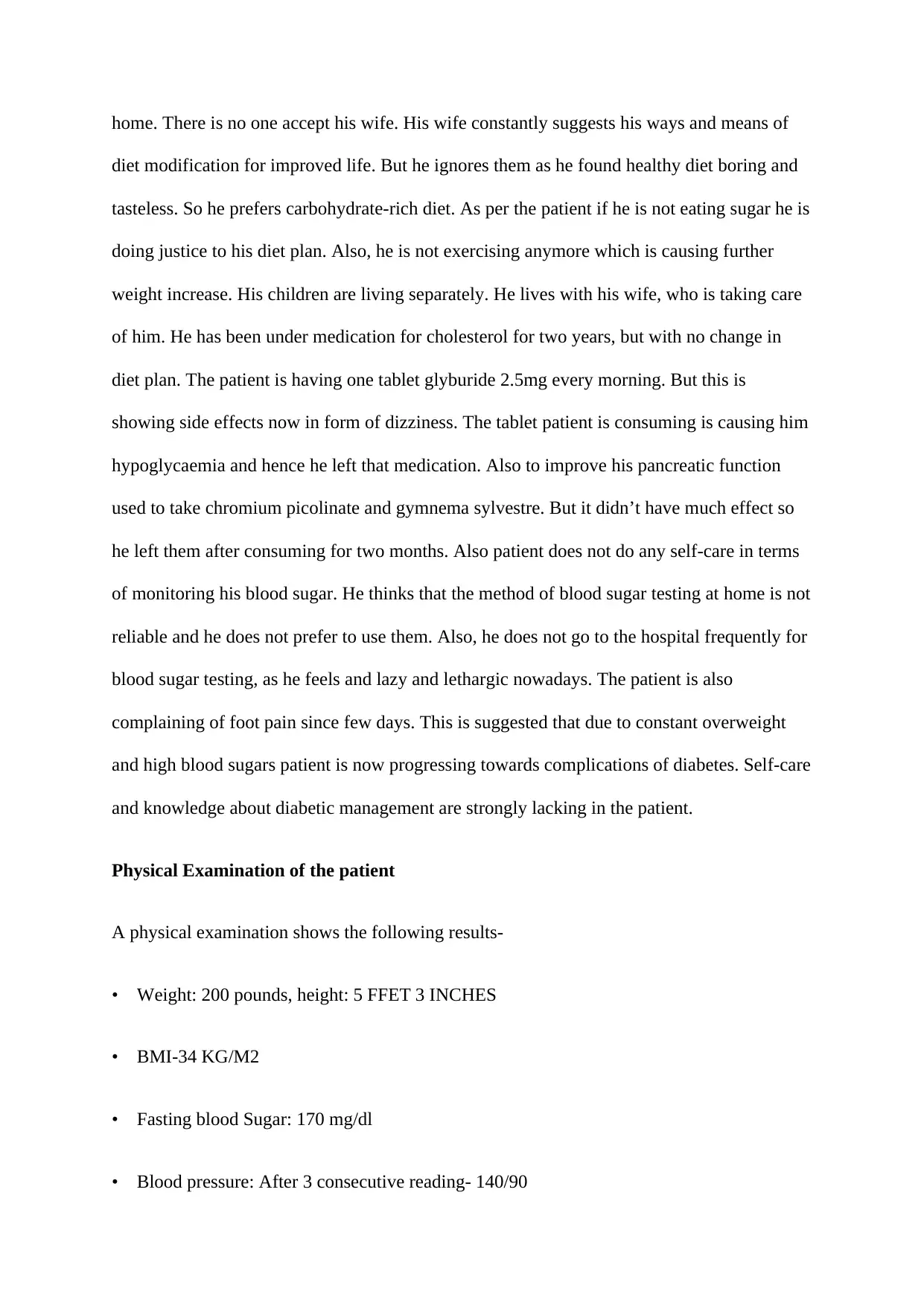
home. There is no one accept his wife. His wife constantly suggests his ways and means of
diet modification for improved life. But he ignores them as he found healthy diet boring and
tasteless. So he prefers carbohydrate-rich diet. As per the patient if he is not eating sugar he is
doing justice to his diet plan. Also, he is not exercising anymore which is causing further
weight increase. His children are living separately. He lives with his wife, who is taking care
of him. He has been under medication for cholesterol for two years, but with no change in
diet plan. The patient is having one tablet glyburide 2.5mg every morning. But this is
showing side effects now in form of dizziness. The tablet patient is consuming is causing him
hypoglycaemia and hence he left that medication. Also to improve his pancreatic function
used to take chromium picolinate and gymnema sylvestre. But it didn’t have much effect so
he left them after consuming for two months. Also patient does not do any self-care in terms
of monitoring his blood sugar. He thinks that the method of blood sugar testing at home is not
reliable and he does not prefer to use them. Also, he does not go to the hospital frequently for
blood sugar testing, as he feels and lazy and lethargic nowadays. The patient is also
complaining of foot pain since few days. This is suggested that due to constant overweight
and high blood sugars patient is now progressing towards complications of diabetes. Self-care
and knowledge about diabetic management are strongly lacking in the patient.
Physical Examination of the patient
A physical examination shows the following results-
• Weight: 200 pounds, height: 5 FFET 3 INCHES
• BMI-34 KG/M2
• Fasting blood Sugar: 170 mg/dl
• Blood pressure: After 3 consecutive reading- 140/90
diet modification for improved life. But he ignores them as he found healthy diet boring and
tasteless. So he prefers carbohydrate-rich diet. As per the patient if he is not eating sugar he is
doing justice to his diet plan. Also, he is not exercising anymore which is causing further
weight increase. His children are living separately. He lives with his wife, who is taking care
of him. He has been under medication for cholesterol for two years, but with no change in
diet plan. The patient is having one tablet glyburide 2.5mg every morning. But this is
showing side effects now in form of dizziness. The tablet patient is consuming is causing him
hypoglycaemia and hence he left that medication. Also to improve his pancreatic function
used to take chromium picolinate and gymnema sylvestre. But it didn’t have much effect so
he left them after consuming for two months. Also patient does not do any self-care in terms
of monitoring his blood sugar. He thinks that the method of blood sugar testing at home is not
reliable and he does not prefer to use them. Also, he does not go to the hospital frequently for
blood sugar testing, as he feels and lazy and lethargic nowadays. The patient is also
complaining of foot pain since few days. This is suggested that due to constant overweight
and high blood sugars patient is now progressing towards complications of diabetes. Self-care
and knowledge about diabetic management are strongly lacking in the patient.
Physical Examination of the patient
A physical examination shows the following results-
• Weight: 200 pounds, height: 5 FFET 3 INCHES
• BMI-34 KG/M2
• Fasting blood Sugar: 170 mg/dl
• Blood pressure: After 3 consecutive reading- 140/90
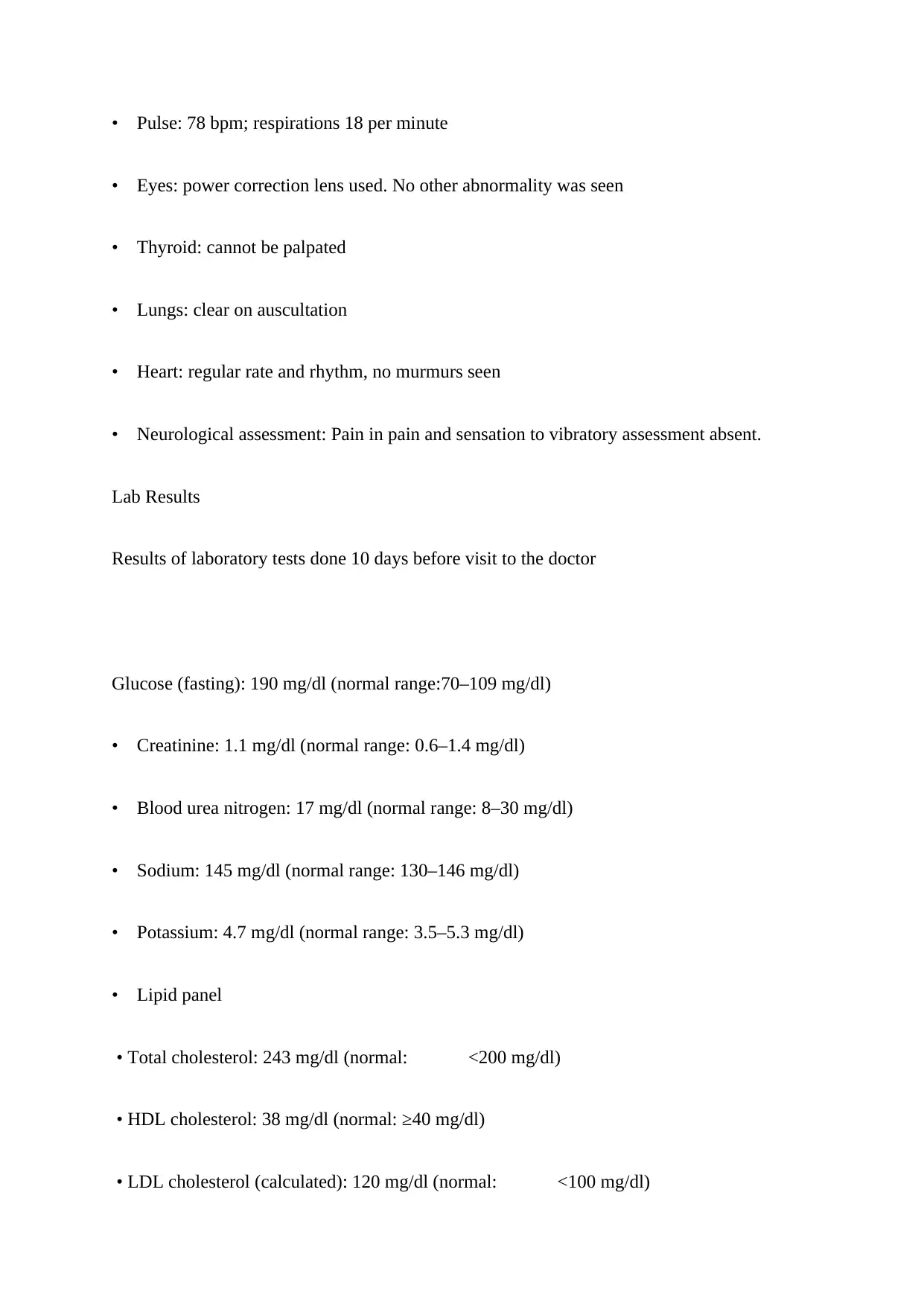
• Pulse: 78 bpm; respirations 18 per minute
• Eyes: power correction lens used. No other abnormality was seen
• Thyroid: cannot be palpated
• Lungs: clear on auscultation
• Heart: regular rate and rhythm, no murmurs seen
• Neurological assessment: Pain in pain and sensation to vibratory assessment absent.
Lab Results
Results of laboratory tests done 10 days before visit to the doctor
Glucose (fasting): 190 mg/dl (normal range:70–109 mg/dl)
• Creatinine: 1.1 mg/dl (normal range: 0.6–1.4 mg/dl)
• Blood urea nitrogen: 17 mg/dl (normal range: 8–30 mg/dl)
• Sodium: 145 mg/dl (normal range: 130–146 mg/dl)
• Potassium: 4.7 mg/dl (normal range: 3.5–5.3 mg/dl)
• Lipid panel
• Total cholesterol: 243 mg/dl (normal: <200 mg/dl)
• HDL cholesterol: 38 mg/dl (normal: ≥40 mg/dl)
• LDL cholesterol (calculated): 120 mg/dl (normal: <100 mg/dl)
• Eyes: power correction lens used. No other abnormality was seen
• Thyroid: cannot be palpated
• Lungs: clear on auscultation
• Heart: regular rate and rhythm, no murmurs seen
• Neurological assessment: Pain in pain and sensation to vibratory assessment absent.
Lab Results
Results of laboratory tests done 10 days before visit to the doctor
Glucose (fasting): 190 mg/dl (normal range:70–109 mg/dl)
• Creatinine: 1.1 mg/dl (normal range: 0.6–1.4 mg/dl)
• Blood urea nitrogen: 17 mg/dl (normal range: 8–30 mg/dl)
• Sodium: 145 mg/dl (normal range: 130–146 mg/dl)
• Potassium: 4.7 mg/dl (normal range: 3.5–5.3 mg/dl)
• Lipid panel
• Total cholesterol: 243 mg/dl (normal: <200 mg/dl)
• HDL cholesterol: 38 mg/dl (normal: ≥40 mg/dl)
• LDL cholesterol (calculated): 120 mg/dl (normal: <100 mg/dl)
Paraphrase This Document
Need a fresh take? Get an instant paraphrase of this document with our AI Paraphraser
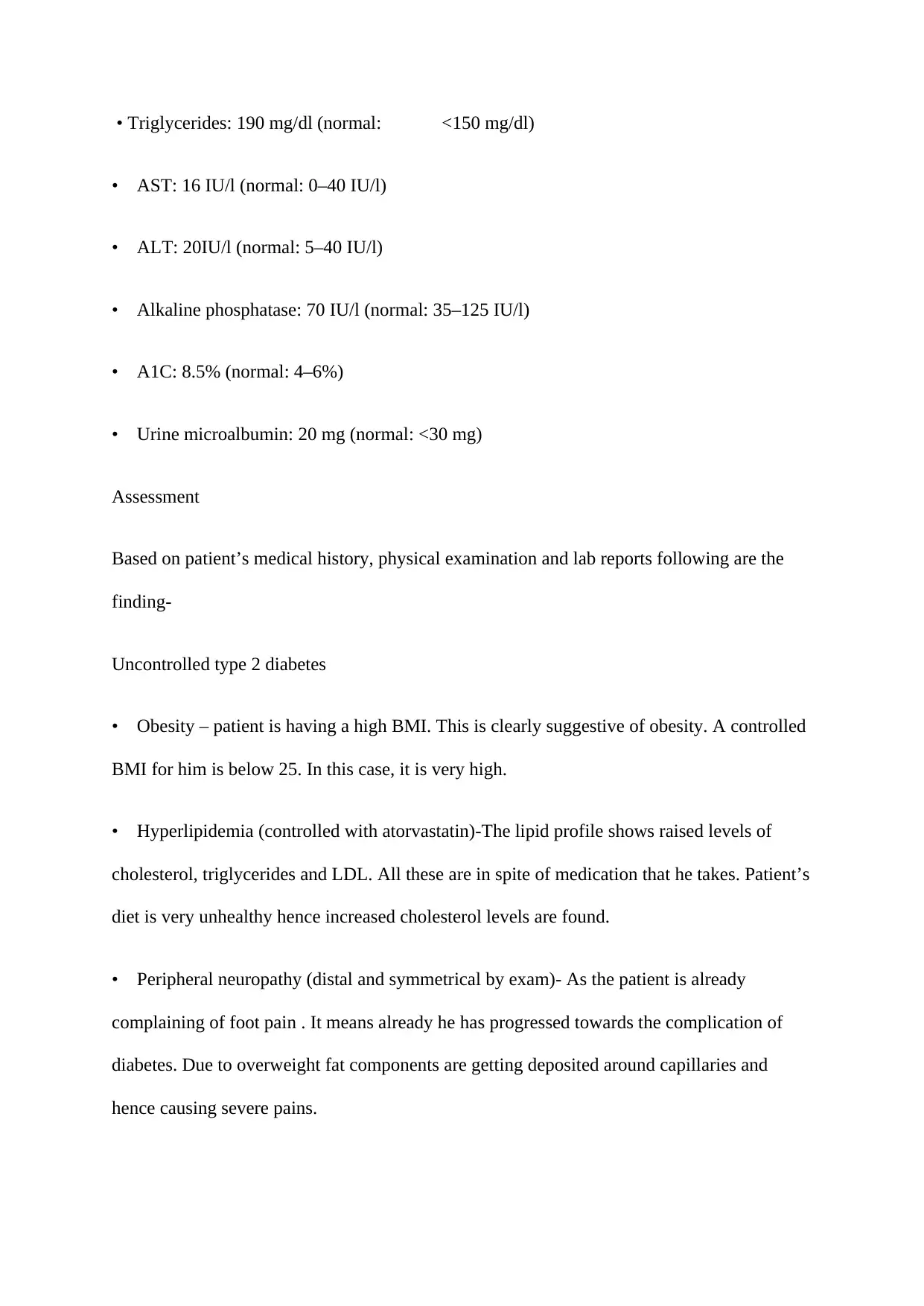
• Triglycerides: 190 mg/dl (normal: <150 mg/dl)
• AST: 16 IU/l (normal: 0–40 IU/l)
• ALT: 20IU/l (normal: 5–40 IU/l)
• Alkaline phosphatase: 70 IU/l (normal: 35–125 IU/l)
• A1C: 8.5% (normal: 4–6%)
• Urine microalbumin: 20 mg (normal: <30 mg)
Assessment
Based on patient’s medical history, physical examination and lab reports following are the
finding-
Uncontrolled type 2 diabetes
• Obesity – patient is having a high BMI. This is clearly suggestive of obesity. A controlled
BMI for him is below 25. In this case, it is very high.
• Hyperlipidemia (controlled with atorvastatin)-The lipid profile shows raised levels of
cholesterol, triglycerides and LDL. All these are in spite of medication that he takes. Patient’s
diet is very unhealthy hence increased cholesterol levels are found.
• Peripheral neuropathy (distal and symmetrical by exam)- As the patient is already
complaining of foot pain . It means already he has progressed towards the complication of
diabetes. Due to overweight fat components are getting deposited around capillaries and
hence causing severe pains.
• AST: 16 IU/l (normal: 0–40 IU/l)
• ALT: 20IU/l (normal: 5–40 IU/l)
• Alkaline phosphatase: 70 IU/l (normal: 35–125 IU/l)
• A1C: 8.5% (normal: 4–6%)
• Urine microalbumin: 20 mg (normal: <30 mg)
Assessment
Based on patient’s medical history, physical examination and lab reports following are the
finding-
Uncontrolled type 2 diabetes
• Obesity – patient is having a high BMI. This is clearly suggestive of obesity. A controlled
BMI for him is below 25. In this case, it is very high.
• Hyperlipidemia (controlled with atorvastatin)-The lipid profile shows raised levels of
cholesterol, triglycerides and LDL. All these are in spite of medication that he takes. Patient’s
diet is very unhealthy hence increased cholesterol levels are found.
• Peripheral neuropathy (distal and symmetrical by exam)- As the patient is already
complaining of foot pain . It means already he has progressed towards the complication of
diabetes. Due to overweight fat components are getting deposited around capillaries and
hence causing severe pains.
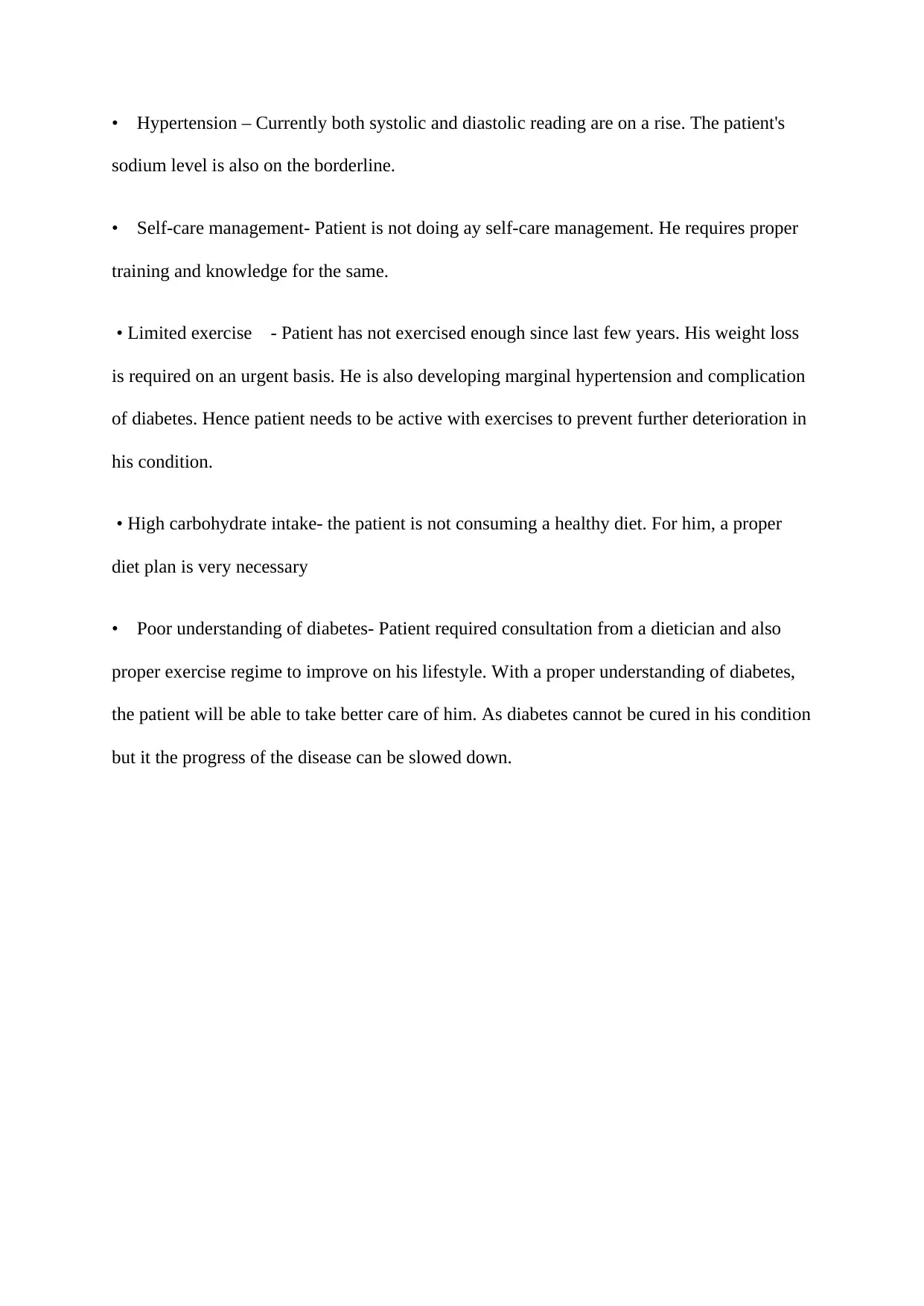
• Hypertension – Currently both systolic and diastolic reading are on a rise. The patient's
sodium level is also on the borderline.
• Self-care management- Patient is not doing ay self-care management. He requires proper
training and knowledge for the same.
• Limited exercise - Patient has not exercised enough since last few years. His weight loss
is required on an urgent basis. He is also developing marginal hypertension and complication
of diabetes. Hence patient needs to be active with exercises to prevent further deterioration in
his condition.
• High carbohydrate intake- the patient is not consuming a healthy diet. For him, a proper
diet plan is very necessary
• Poor understanding of diabetes- Patient required consultation from a dietician and also
proper exercise regime to improve on his lifestyle. With a proper understanding of diabetes,
the patient will be able to take better care of him. As diabetes cannot be cured in his condition
but it the progress of the disease can be slowed down.
sodium level is also on the borderline.
• Self-care management- Patient is not doing ay self-care management. He requires proper
training and knowledge for the same.
• Limited exercise - Patient has not exercised enough since last few years. His weight loss
is required on an urgent basis. He is also developing marginal hypertension and complication
of diabetes. Hence patient needs to be active with exercises to prevent further deterioration in
his condition.
• High carbohydrate intake- the patient is not consuming a healthy diet. For him, a proper
diet plan is very necessary
• Poor understanding of diabetes- Patient required consultation from a dietician and also
proper exercise regime to improve on his lifestyle. With a proper understanding of diabetes,
the patient will be able to take better care of him. As diabetes cannot be cured in his condition
but it the progress of the disease can be slowed down.
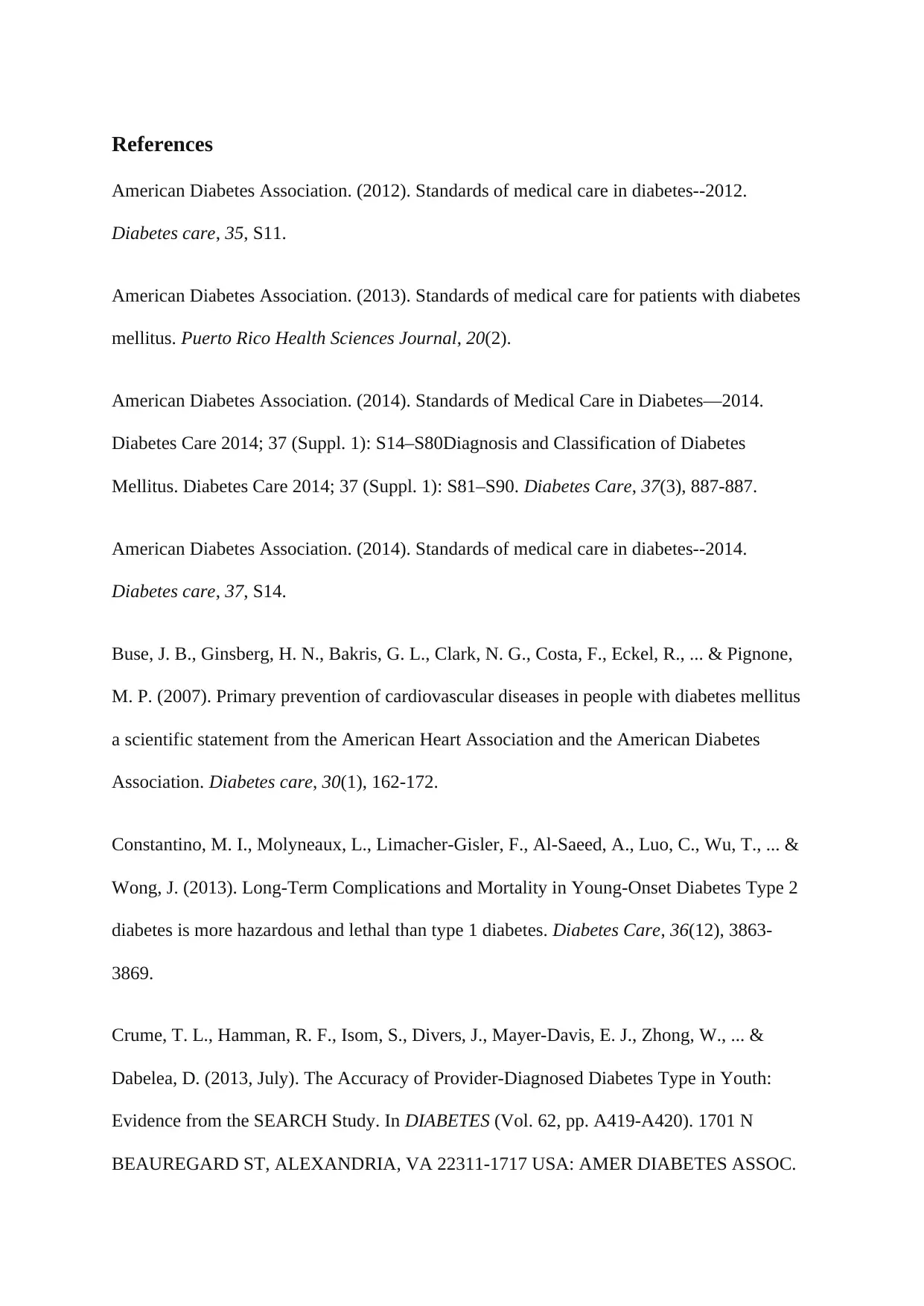
References
American Diabetes Association. (2012). Standards of medical care in diabetes--2012.
Diabetes care, 35, S11.
American Diabetes Association. (2013). Standards of medical care for patients with diabetes
mellitus. Puerto Rico Health Sciences Journal, 20(2).
American Diabetes Association. (2014). Standards of Medical Care in Diabetes—2014.
Diabetes Care 2014; 37 (Suppl. 1): S14–S80Diagnosis and Classification of Diabetes
Mellitus. Diabetes Care 2014; 37 (Suppl. 1): S81–S90. Diabetes Care, 37(3), 887-887.
American Diabetes Association. (2014). Standards of medical care in diabetes--2014.
Diabetes care, 37, S14.
Buse, J. B., Ginsberg, H. N., Bakris, G. L., Clark, N. G., Costa, F., Eckel, R., ... & Pignone,
M. P. (2007). Primary prevention of cardiovascular diseases in people with diabetes mellitus
a scientific statement from the American Heart Association and the American Diabetes
Association. Diabetes care, 30(1), 162-172.
Constantino, M. I., Molyneaux, L., Limacher-Gisler, F., Al-Saeed, A., Luo, C., Wu, T., ... &
Wong, J. (2013). Long-Term Complications and Mortality in Young-Onset Diabetes Type 2
diabetes is more hazardous and lethal than type 1 diabetes. Diabetes Care, 36(12), 3863-
3869.
Crume, T. L., Hamman, R. F., Isom, S., Divers, J., Mayer-Davis, E. J., Zhong, W., ... &
Dabelea, D. (2013, July). The Accuracy of Provider-Diagnosed Diabetes Type in Youth:
Evidence from the SEARCH Study. In DIABETES (Vol. 62, pp. A419-A420). 1701 N
BEAUREGARD ST, ALEXANDRIA, VA 22311-1717 USA: AMER DIABETES ASSOC.
American Diabetes Association. (2012). Standards of medical care in diabetes--2012.
Diabetes care, 35, S11.
American Diabetes Association. (2013). Standards of medical care for patients with diabetes
mellitus. Puerto Rico Health Sciences Journal, 20(2).
American Diabetes Association. (2014). Standards of Medical Care in Diabetes—2014.
Diabetes Care 2014; 37 (Suppl. 1): S14–S80Diagnosis and Classification of Diabetes
Mellitus. Diabetes Care 2014; 37 (Suppl. 1): S81–S90. Diabetes Care, 37(3), 887-887.
American Diabetes Association. (2014). Standards of medical care in diabetes--2014.
Diabetes care, 37, S14.
Buse, J. B., Ginsberg, H. N., Bakris, G. L., Clark, N. G., Costa, F., Eckel, R., ... & Pignone,
M. P. (2007). Primary prevention of cardiovascular diseases in people with diabetes mellitus
a scientific statement from the American Heart Association and the American Diabetes
Association. Diabetes care, 30(1), 162-172.
Constantino, M. I., Molyneaux, L., Limacher-Gisler, F., Al-Saeed, A., Luo, C., Wu, T., ... &
Wong, J. (2013). Long-Term Complications and Mortality in Young-Onset Diabetes Type 2
diabetes is more hazardous and lethal than type 1 diabetes. Diabetes Care, 36(12), 3863-
3869.
Crume, T. L., Hamman, R. F., Isom, S., Divers, J., Mayer-Davis, E. J., Zhong, W., ... &
Dabelea, D. (2013, July). The Accuracy of Provider-Diagnosed Diabetes Type in Youth:
Evidence from the SEARCH Study. In DIABETES (Vol. 62, pp. A419-A420). 1701 N
BEAUREGARD ST, ALEXANDRIA, VA 22311-1717 USA: AMER DIABETES ASSOC.
Secure Best Marks with AI Grader
Need help grading? Try our AI Grader for instant feedback on your assignments.
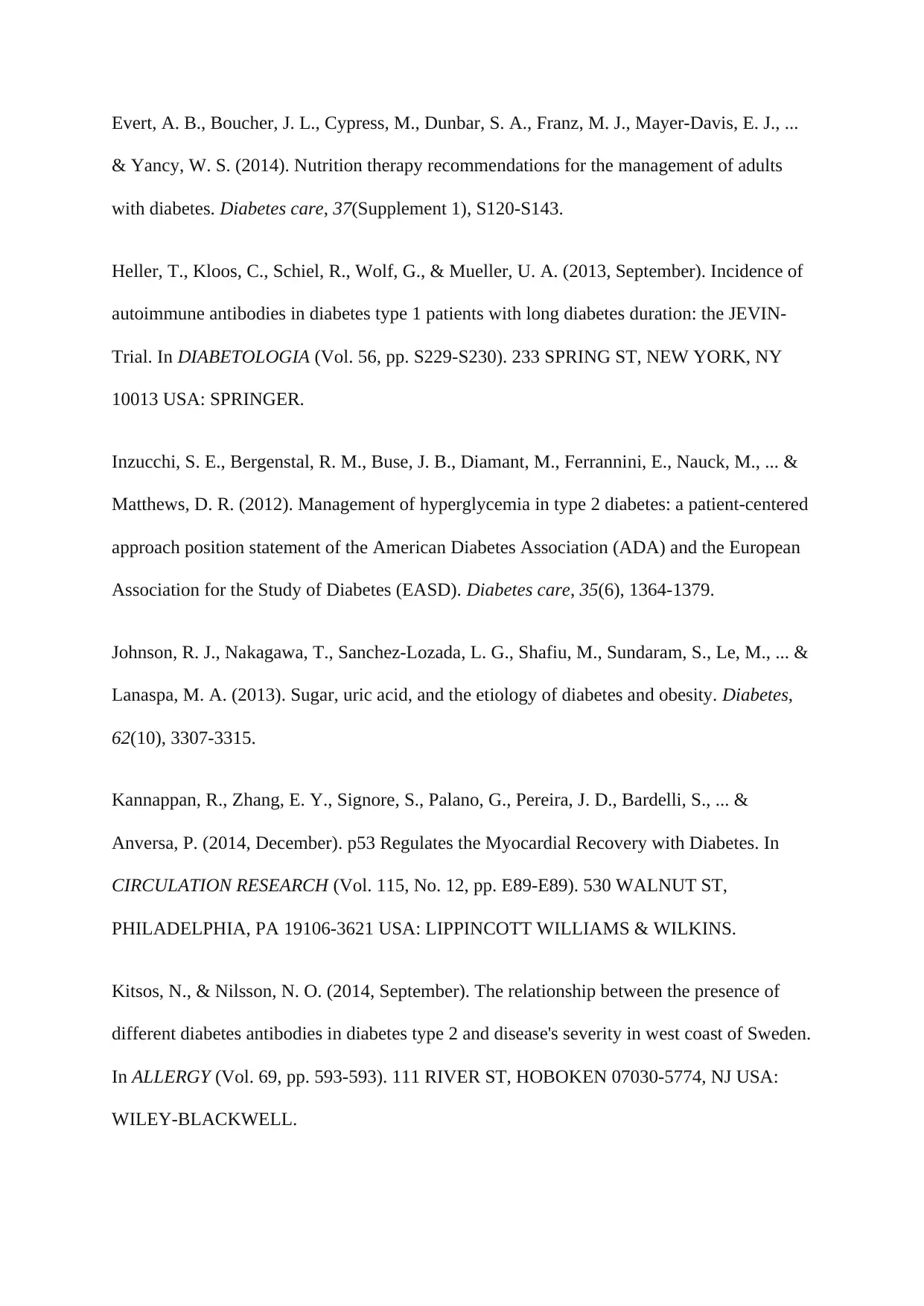
Evert, A. B., Boucher, J. L., Cypress, M., Dunbar, S. A., Franz, M. J., Mayer-Davis, E. J., ...
& Yancy, W. S. (2014). Nutrition therapy recommendations for the management of adults
with diabetes. Diabetes care, 37(Supplement 1), S120-S143.
Heller, T., Kloos, C., Schiel, R., Wolf, G., & Mueller, U. A. (2013, September). Incidence of
autoimmune antibodies in diabetes type 1 patients with long diabetes duration: the JEVIN-
Trial. In DIABETOLOGIA (Vol. 56, pp. S229-S230). 233 SPRING ST, NEW YORK, NY
10013 USA: SPRINGER.
Inzucchi, S. E., Bergenstal, R. M., Buse, J. B., Diamant, M., Ferrannini, E., Nauck, M., ... &
Matthews, D. R. (2012). Management of hyperglycemia in type 2 diabetes: a patient-centered
approach position statement of the American Diabetes Association (ADA) and the European
Association for the Study of Diabetes (EASD). Diabetes care, 35(6), 1364-1379.
Johnson, R. J., Nakagawa, T., Sanchez-Lozada, L. G., Shafiu, M., Sundaram, S., Le, M., ... &
Lanaspa, M. A. (2013). Sugar, uric acid, and the etiology of diabetes and obesity. Diabetes,
62(10), 3307-3315.
Kannappan, R., Zhang, E. Y., Signore, S., Palano, G., Pereira, J. D., Bardelli, S., ... &
Anversa, P. (2014, December). p53 Regulates the Myocardial Recovery with Diabetes. In
CIRCULATION RESEARCH (Vol. 115, No. 12, pp. E89-E89). 530 WALNUT ST,
PHILADELPHIA, PA 19106-3621 USA: LIPPINCOTT WILLIAMS & WILKINS.
Kitsos, N., & Nilsson, N. O. (2014, September). The relationship between the presence of
different diabetes antibodies in diabetes type 2 and disease's severity in west coast of Sweden.
In ALLERGY (Vol. 69, pp. 593-593). 111 RIVER ST, HOBOKEN 07030-5774, NJ USA:
WILEY-BLACKWELL.
& Yancy, W. S. (2014). Nutrition therapy recommendations for the management of adults
with diabetes. Diabetes care, 37(Supplement 1), S120-S143.
Heller, T., Kloos, C., Schiel, R., Wolf, G., & Mueller, U. A. (2013, September). Incidence of
autoimmune antibodies in diabetes type 1 patients with long diabetes duration: the JEVIN-
Trial. In DIABETOLOGIA (Vol. 56, pp. S229-S230). 233 SPRING ST, NEW YORK, NY
10013 USA: SPRINGER.
Inzucchi, S. E., Bergenstal, R. M., Buse, J. B., Diamant, M., Ferrannini, E., Nauck, M., ... &
Matthews, D. R. (2012). Management of hyperglycemia in type 2 diabetes: a patient-centered
approach position statement of the American Diabetes Association (ADA) and the European
Association for the Study of Diabetes (EASD). Diabetes care, 35(6), 1364-1379.
Johnson, R. J., Nakagawa, T., Sanchez-Lozada, L. G., Shafiu, M., Sundaram, S., Le, M., ... &
Lanaspa, M. A. (2013). Sugar, uric acid, and the etiology of diabetes and obesity. Diabetes,
62(10), 3307-3315.
Kannappan, R., Zhang, E. Y., Signore, S., Palano, G., Pereira, J. D., Bardelli, S., ... &
Anversa, P. (2014, December). p53 Regulates the Myocardial Recovery with Diabetes. In
CIRCULATION RESEARCH (Vol. 115, No. 12, pp. E89-E89). 530 WALNUT ST,
PHILADELPHIA, PA 19106-3621 USA: LIPPINCOTT WILLIAMS & WILKINS.
Kitsos, N., & Nilsson, N. O. (2014, September). The relationship between the presence of
different diabetes antibodies in diabetes type 2 and disease's severity in west coast of Sweden.
In ALLERGY (Vol. 69, pp. 593-593). 111 RIVER ST, HOBOKEN 07030-5774, NJ USA:
WILEY-BLACKWELL.

Look AHEAD Research Group. (2013). Cardiovascular effects of intensive lifestyle
intervention in type 2 diabetes. N engl J med, 2013(369), 145-154.
Sarwar, K. N., Gillani, S. M. R., Singh, B. M., Saravanan, P., & Narendran, P. (2015,
September). A comparison of diabetes type 1 in South Asian and Caucasian patients in the
UK: the Type 1 in Minority Ethnic populations (TIME) study. In DIABETOLOGIA (Vol. 58,
pp. S168-S168). 233 SPRING ST, NEW YORK, NY 10013 USA: SPRINGER.
Scirica, B. M., Bhatt, D. L., Braunwald, E., Steg, P. G., Davidson, J., Hirshberg, B., ... &
Cavender, M. A. (2013). Saxagliptin and cardiovascular outcomes in patients with type 2
diabetes mellitus. New England Journal of Medicine, 369(14), 1317-1326.
Spaleniak, S., Korzeniewska-Dyl, I., & Moczulski, D. (2014). Serum uric acid concentration
is associated with early changes of glomerular filtration rate in patients with diabetes type 1
without increased albumin excretion. Polski merkuriusz lekarski: organ Polskiego
Towarzystwa Lekarskiego, 37(220), 217-220.
Toperoff, G., Aran, D., Kark, J. D., Rosenberg, M., Dubnikov, T., Nissan, B., ... & Hellman,
A. (2012). Genome-wide survey reveals predisposing diabetes type 2-related DNA
methylation variations in human peripheral blood. Human molecular genetics, 21(2), 371-
383.
Walter, J. (2013). Adolescents with diabetes type 1 in adolescent psychiatry and
psychotherapy. Praxis der Kinderpsychologie und Kinderpsychiatrie, 62(9), 707.
White, W. B., Cannon, C. P., Heller, S. R., Nissen, S. E., Bergenstal, R. M., Bakris, G. L., ...
& Wilson, C. (2013). Alogliptin after acute coronary syndrome in patients with type 2
diabetes. New England Journal of Medicine, 369(14), 1327-1335.
intervention in type 2 diabetes. N engl J med, 2013(369), 145-154.
Sarwar, K. N., Gillani, S. M. R., Singh, B. M., Saravanan, P., & Narendran, P. (2015,
September). A comparison of diabetes type 1 in South Asian and Caucasian patients in the
UK: the Type 1 in Minority Ethnic populations (TIME) study. In DIABETOLOGIA (Vol. 58,
pp. S168-S168). 233 SPRING ST, NEW YORK, NY 10013 USA: SPRINGER.
Scirica, B. M., Bhatt, D. L., Braunwald, E., Steg, P. G., Davidson, J., Hirshberg, B., ... &
Cavender, M. A. (2013). Saxagliptin and cardiovascular outcomes in patients with type 2
diabetes mellitus. New England Journal of Medicine, 369(14), 1317-1326.
Spaleniak, S., Korzeniewska-Dyl, I., & Moczulski, D. (2014). Serum uric acid concentration
is associated with early changes of glomerular filtration rate in patients with diabetes type 1
without increased albumin excretion. Polski merkuriusz lekarski: organ Polskiego
Towarzystwa Lekarskiego, 37(220), 217-220.
Toperoff, G., Aran, D., Kark, J. D., Rosenberg, M., Dubnikov, T., Nissan, B., ... & Hellman,
A. (2012). Genome-wide survey reveals predisposing diabetes type 2-related DNA
methylation variations in human peripheral blood. Human molecular genetics, 21(2), 371-
383.
Walter, J. (2013). Adolescents with diabetes type 1 in adolescent psychiatry and
psychotherapy. Praxis der Kinderpsychologie und Kinderpsychiatrie, 62(9), 707.
White, W. B., Cannon, C. P., Heller, S. R., Nissen, S. E., Bergenstal, R. M., Bakris, G. L., ...
& Wilson, C. (2013). Alogliptin after acute coronary syndrome in patients with type 2
diabetes. New England Journal of Medicine, 369(14), 1327-1335.
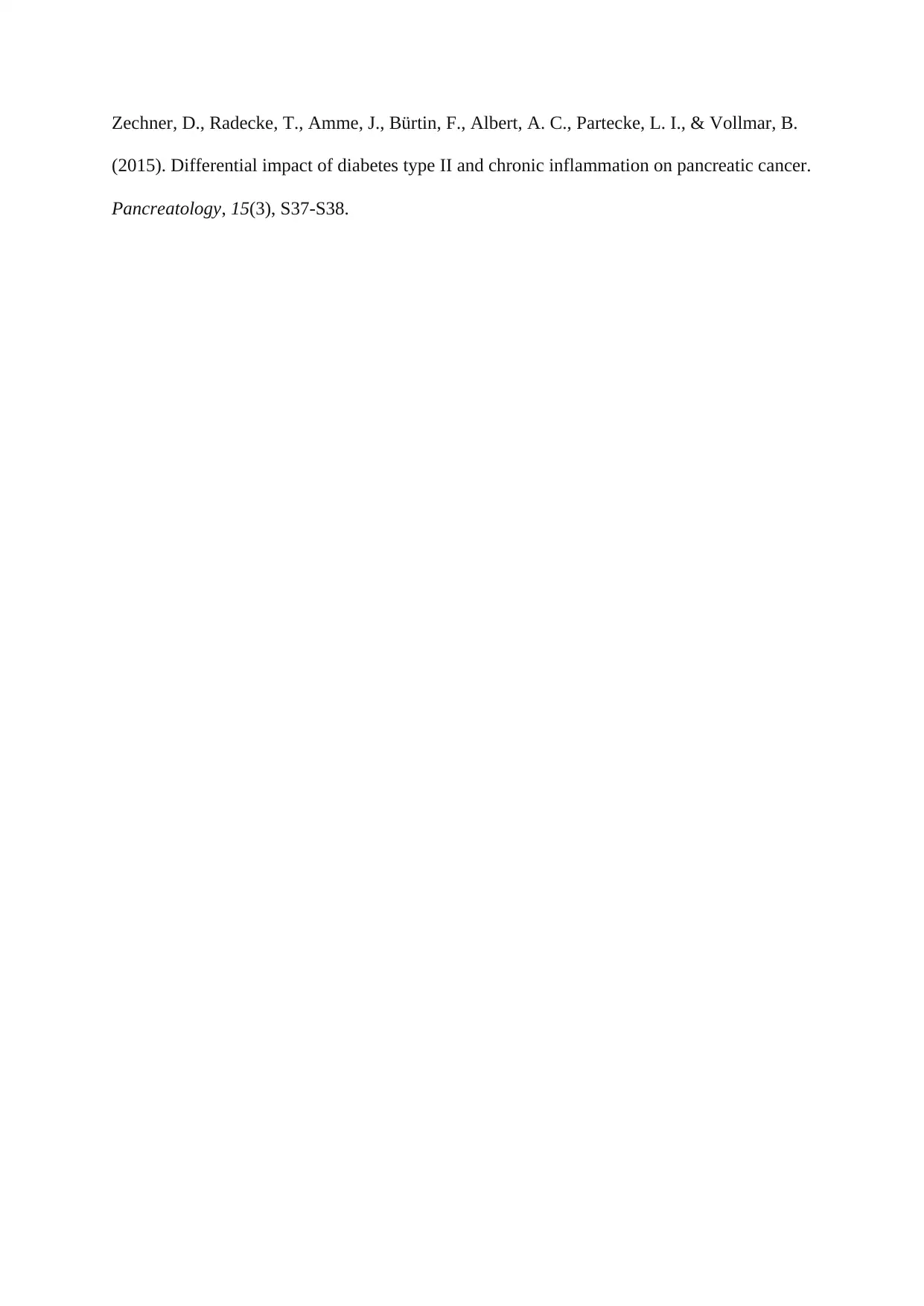
Zechner, D., Radecke, T., Amme, J., Bürtin, F., Albert, A. C., Partecke, L. I., & Vollmar, B.
(2015). Differential impact of diabetes type II and chronic inflammation on pancreatic cancer.
Pancreatology, 15(3), S37-S38.
(2015). Differential impact of diabetes type II and chronic inflammation on pancreatic cancer.
Pancreatology, 15(3), S37-S38.
1 out of 16
Related Documents
Your All-in-One AI-Powered Toolkit for Academic Success.
+13062052269
info@desklib.com
Available 24*7 on WhatsApp / Email
![[object Object]](/_next/static/media/star-bottom.7253800d.svg)
Unlock your academic potential
© 2024 | Zucol Services PVT LTD | All rights reserved.




